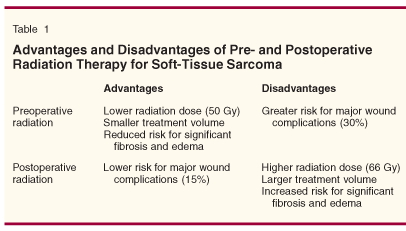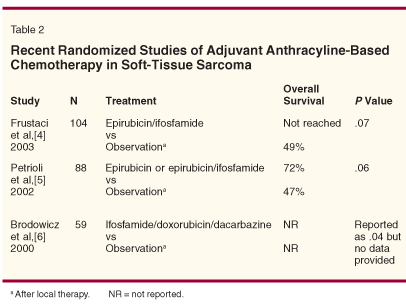Treatment of Localized Soft-Tissue Sarcoma: Lessons Learned
Over the past 30 years, there has been a migration away from amputation and radical ablative surgical procedures and toward more conservative, function-preserving surgery combined with radiation to treat extremity and body wall soft-tissue sarcomas. Efforts are now being focused on optimizing and streamlining treatment, including identifying subpopulations of patients who may be adequately treated by surgery alone. The goal of these efforts is to minimize the risks for short- and long-term treatment-related morbidity while maintaining excellent rates of local tumor control. This report will briefly review the progress made in these areas.
Over the past 30 years, there has been a migration away from amputation and radical ablative surgical procedures and toward more conservative, function-preserving surgery combined with radiation to treat extremity and body wall soft-tissue sarcomas. Efforts are now being focused on optimizing and streamlining treatment, including identifying subpopulations of patients who may be adequately treated by surgery alone. The goal of these efforts is to minimize the risks for short- and long-term treatment-related morbidity while maintaining excellent rates of local tumor control. This report will briefly review the progress made in these areas.
The primary therapy for most (but not all) patients with localized soft-tissue sarcoma is surgical resection plus radiation. The evidence base for this treatment approach comes from two small, single-institution, randomized trials that demonstrated improved local control (but not survival) with surgery plus radiation.[1,2] On the basis of these two trials, a general standard of care for patients with localized sarcomas has evolved that includes surgery and radiation.
Optimal Treatment Sequence
Considerable attention has been focused on the optimal sequence of surgery and radiation. This is because both pre- and postoperative radiation offer specific advantages but are associated with specific risks (Table 1). Preoperative radiation generally is administered using a lower total dose (50 Gy) and smaller treatment volume than postoperative radiation (65 Gy). These differences are clinically significant since the lower dose and smaller treatment volume used with preoperative radiation result in lower risks for serious late treatment-related adverse effects including edema and fibrosis. However, the risks for short-term side effects-particularly radiation-related impairment in wound healing leading to major wound complications-is higher with preoperative radiation than postoperative radiation. Because the local control rates with these two approaches appear similar, assessment of the risks for these clinically significant short- and long-term side effects assumes considerable importance in individual patient treatment planning.

The single best evidence source evaluating treatment sequencing comes from the Canadian Sarcoma Group's SR2 randomized trial of pre- vs postoperative radiation.[3] This trial randomly assigned patients with localized primary or recurrent extremity sarcomas to be treated using external-beam radiation (50 Gy with a 16-Gy boost for microscopically positive surgical margins) followed by surgery, or surgery followed by external-beam radiation (66 Gy). The primary endpoint was wound complications; a number of clinically relevant secondary endpoints were also evaluated, including late complications and quality-of-life issues.
Radiation-associated wound complications were more common in patients receiving preoperative radiation-a 33% wound complication rate in the preoperative radiation arm vs 16% in the postoperative radiation arm. However, late (generally irreversible) tissue effects including fibrosis and edema were more common following postoperative radiation. This was related to the higher radiation dose and larger field size required for postoperative radiation. Other late complications including second malignancies will presumably be reported when additional patient follow-up is available.
The results of the SR2 trial also suggest that local anatomic factors including tumor size and anatomic location should be considered in determining the optimal treatment sequence for a given patient. For example, patients with an upper-extremity tumor should be considered for preoperative radiation given the low risk for radiation-associated wound complications and low risk for treatment-related edema and fibrosis associated with preoperative radiation in this group. However, in patients with lower-extremity sarcomas, particularly those located in the upper thigh, where wound complications were most frequent in the SR2 study, postoperative radiation might be a better choice. In either case, patients should be counseled regarding the complex issues involved.
Adjuvant Chemotherapy
Over the past 25 years, extensive effort has also been directed toward determining whether anthracycline-based adjuvant chemotherapy offers a clinically meaningful benefit in patients with localized soft-tissue sarcoma. A summary of the second-generation randomized adjuvant chemotherapy trials is provided in Table 2.[4-6] These studies generally included more modern chemotherapy (agents, dose, and schedule) than were used in earlier-generation adjuvant chemotherapy trials performed in the 1970s and 1980s. None of the trials demonstrated any statistically significant impact of adjuvant chemotherapy on overall survival, but they were likely underpowered for this endpoint. The question of whether patients with high-risk (ie, American Joint Committee on Cancer stage III) tumors should be routinely offered adjuvant chemotherapy remains an open issue about which there has been considerable discussion and debate.

Neoadjuvant Chemotherapy
A related issue of considerable importance to patients and physicians is the specific impact of preoperative chemotherapy on the scope and morbidity of subsequent surgery. For patients with other types of high-risk primary tumors, such as rectal cancer or localized or locally advanced breast cancer breast cancer, preoperative chemotherapy is routinely used, and responses can result in clinically meaningful changes in the scope of surgery. However, studies addressing the "downstaging" effects of preoperative treatment for patients with soft-tissue sarcoma are quite limited.
In a retrospective study from The University of Texas M. D. Anderson Cancer Center, my colleagues and I evaluated radiologic response rates to anthracycline-based preoperative chemotherapy in patients with stage III soft-tissue sarcoma.[7] The study included a review of the pretreatment and preoperative cross-sectional images by a single radiologist. Objective radiologically confirmed responses were identified in 27% of the patients treated with preoperative doxorubicin-based chemotherapy. However, a similar fraction of patients (30%) experienced objective primary tumor progression during this treatment.
In a separate study of a nonoverlapping group of 65 patients treated with doxorubicin/ifosfamide-based preoperative chemotherapy, the objective radiologic response rate was 34%, and the objective radiologically determined rate of disease progression was 26%-similar to what had been seen in the earlier study. When the pretreatment and immediately preoperative computed tomography scans of the patients in the second study were reviewed by a panel of three sarcoma surgeons, the treatment-associated response was judged to warrant a decrease in planned surgery in 13% of patients but an increase in 9% of patients owing to disease progression during preoperative treatment.
The impact of preoperative chemotherapy on the scope of surgery, on R0 (microscopically negative margins) resection rates, and on the morbidity of surgery are important issues that have been largely overlooked in studies. Given the currently available data, patients with localized primary sarcomas considering preoperative chemotherapy should be counseled regarding the potential albeit inconclusively proven advantages of such treatment. The discussion should include the risks for short- and long-term chemotherapy-related toxicities and the similar likelihoods of primary tumor response and primary tumor progression associated with preoperative chemotherapy and delayed surgery.
Conclusions
As we move forward with research, it is clear that additional trials are needed for patients with localized soft-tissue sarcoma. The design of these trials is likely to be complex and will require the use of surrogate endpoints because traditional endpoints such as local control and overall survival require prohibitively large sample sizes for such a rare disease, particularly if histology-specific trials are undertaken. In addition to new clinical trial designs, we desperately need new chemotherapeutic agents for this disease, as we are largely relying on drugs developed in the 1970s. Meaningful progress will undoubtedly require collaboration between researchers, institutions, and organized sarcoma research groups; support from the US National Cancer Institute and other agencies; and a better understanding of the biology of these tumors to enable identification of new targets for drug development.
References:
1. Pisters PW, Harrison LB, Leung DH, et al: Long-term results of a prospective randomized trial of adjuvant brachytherapy in soft tissue sarcoma. J Clin Oncol 14:859-868, 1996.
2. Yang JC, Chang AE, Baker AR, et al: A randomized prospective study of the benefit of adjuvant radiation therapy in the treatment of soft tissue sarcomas of the extremity. J Clin Oncol 16:197-203, 1998.
3. O'Sullivan B, Davis AM, Turcotte R, et al: Preoperative versus postoperative radiotherapy in soft-tissue sarcoma of the limbs: A randomized trial. Lancet 359:2235-2241,
2002.
4. Frustaci S, De Paoli A, Bidoli E, et al: Ifosfamide in the adjuvant therapy of soft tissue sarcomas. Oncology 65(suppl 2):80-84, 2003.
5. Petrioli R, Coratti A, Correale P, et al: Adjuvant epirubicin with or without ifosfamide for adult soft-tissue sarcoma. Am J Clin Oncol 25:468-473, 2002.
6. Brodowicz T, Schwameis E, Widder J, et al: Intensified adjuvant IFADIC chemotherapy for adult soft tissue sarcoma: A prospective randomized feasibility trial. Sarcoma 4:151-160, 2000.
7. Pisters PWT, Patel SR, Varma DGK, et al: Preoperative chemotherapy for stage IIIB extremity soft tissue sarcoma: Long-term results from a single institution. J Clin Oncol 15:3481-3487, 1997.